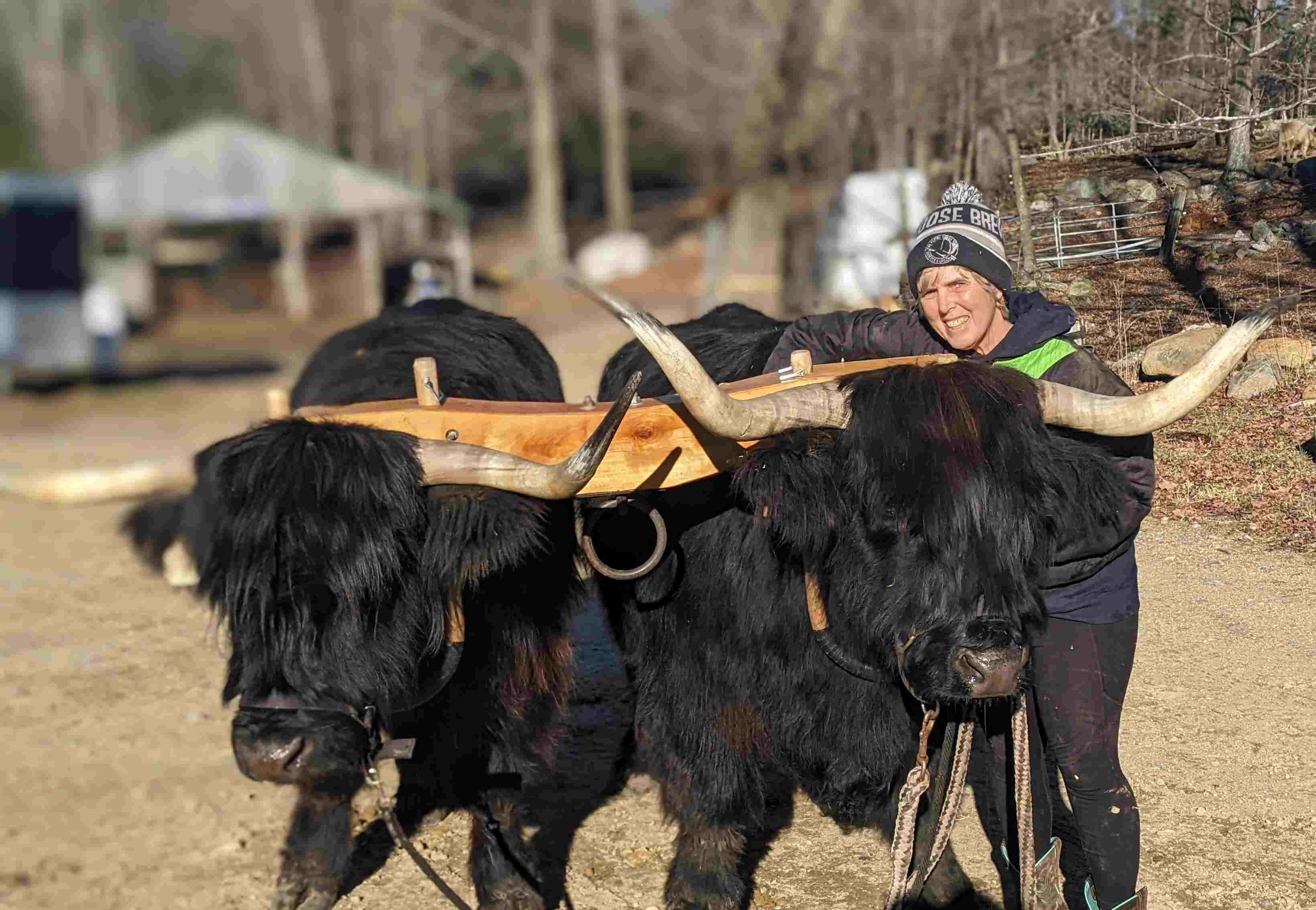How To Be A Herd Leader
posted on
December 14, 2020
 Topper, a Scottish Highlander steer, is a stand-in for Rudolph while Bruce and author, Carole, sit in his sleigh and Tazzy, the mini pig, waits for treats. Topper is a farm “ambassador.”
Topper, a Scottish Highlander steer, is a stand-in for Rudolph while Bruce and author, Carole, sit in his sleigh and Tazzy, the mini pig, waits for treats. Topper is a farm “ambassador.”
Stash watched from behind the fence as I worked with his teammate, Topper. They are 8-year-old Scottish Highlander oxen, whom I call the "the boys." In past years, the three of us competed at the Hopkinton Fair – the two of them in a yoke with me (the brains of the outfit) directing their efforts. This year, with no fairs, they need another job, so I've decided to put them to work pulling logs out of the woods to be cut into firewood.
They've had almost a year off, eating grass and hanging out in the pasture, so they needed some tuning-up before I put them to work. Imagine leaving a car in the garage for a year, with battery dying, fluids dripping, tires leaking, and seals cracking. It would need some attention before you drive it.
As for my oxen, I know their water and fuel tanks are topped off, but I needed to tune-up their response to commands.
How To Tune-Up A Steer
They still knew their names and a few words like "gee" (right), "haw" (left), and "walk on." But they conveniently forgot the hated-by-oxen command of "back." Cattle are visual and like to see where they are stepping. Despite their long bangs, they see well to the front and sides, but of course, they can't see what's behind them. During the tune-up, when I gave the "back" command, Stash stepped sideways. With repetition, he finally trusted that I would not ask him to step off a cliff or into a hole, and he backed up correctly.
"Wait" is another challenging command for some oxen. It means that they must stand still even if their driver is not in sight. Imagine if I'm behind them hooking up a log, and they decide to walk forward before I get out of the way -- smooshed Carole. Thankfully my boys are naturally lazy. Even with rusty skills, Topper and Stash needed little reminding to stand in place.
Leading with Confidence
But it's not just about vocabulary. I've learned that if another person issues the same commands, often the boys will not cooperate. Style of delivery is a factor. In last week's column, I told how I use energy and attitude to keep my place as herd leader.
To start, I clear my mind of any anxious thoughts like, "Will Topper do what I want?" or "Will he swing his horns and hit me?" Then I move on with confidence.
These are big boys; 1,500 pounds each. I'm short, 5-foot-3, with proportionally shorter arms. I have to be convincing. Touch is one way to communicate energy, so to make my arms longer, I carry a long stick called a "goad." I don't use the goad to punish or beat them; I use it as an extension of my arm.
Hollering Doesn’t Work
Sometimes Topper or Stash get distracted. Like an inattentive child, an ox can only learn when he pays attention. I gently refocus him with a touch of the goad. Hollering doesn't work. Have you noticed that when you yell at your children, your dog, your spouse, that they tend to tune you out? Steers are the same.
But there's no tuning me out when I am calm, assertive, and intentional. This works with the rest of the herd, too, but it's more dramatic with my oxen. Every command I give, I expect them to follow. I use positive reinforcement instead of yelling or anger. So, when Stash would rather eat grass than turn left, I replace anger with calmness, and he cooperates.
Working Together Is Inspiring
My heart soars when Topper and Stash work together to pull a log from the woods. I'm like the Fisher Cats' coach when his infielders execute a perfect double play.
I don't know much about baseball, but here on the farm, it's energy and sometimes a long arm that makes me the leader of my team. How do you get help around the house? Are you positive or negative? The right energy works wonders.



